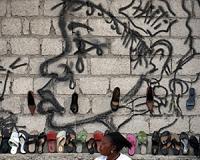| . |  |
. |
Rampur, India (AFP) April 15, 2010 Indian aid workers battled blocked roads and downed power lines Thursday as they rushed aid to victims of a giant tornado that ravaged hundreds of thousands of homes and killed 129 people. In West Bengal state, 250,000 people were made homeless by the twister, which packed winds of up to 120 kilometres (75 miles) an hour as it tore across isolated rural areas of northeast India and Bangladesh overnight Tuesday. "We are facing a crisis in the relief operation. There is a shortage of manpower to distribute rice and medical aid among the victims," West Bengal minister for civil defence Srikumar Mukherji told AFP. Uprooted trees blocking roads and broken electricity lines were further slowing down attempts to deliver aid, he said. The storm, which brought torrential rain and high winds over a wide area, also killed thousands of cattle and ruined summer crops in the area, one of the poorest in India whose residents survive as subsistence farmers. State officials across northeast India said a total of 127 people had been killed, with new victims reported Thursday in West Bengal, Bihar state and northeastern Meghalaya. Two others lost their lives in neighbouring Bangladesh. In Rampur village, 200 miles (320 kilometres) north of West Bengal capital Kolkata, the roof of every house had collapsed or been blown away. Thousands of stranded people were taking shelter in school and temple premises. Food aid in the form of rice and dried fruit was beginning to arrive as well as tarpaulins and plastic sheets, though distribution efforts were still not reaching most of the victims. The National Disaster Management Authority in New Delhi said state governments were conducting relief operations. "We offered to help but they said they are capable of dealing with the disaster and will seek help if required," senior official K.M. Singh told AFP in New Delhi. Witnesses to the destructive power of the storm described their terror as the winds and rain struck around midnight Tuesday. "The thatched roof fell on our head and then after two minutes the entire house fell on us," said Ratan Burman, a 45-year-old farmer, who lost his wife in the disaster. "I managed to come out and pull my two sons out, but I was unable to save my wife." A local weather office official said part of the storm had a "twister effect with the shape of an elephant trunk," which had formed out of 18-kilometre (11-mile) thick thunderclouds. A long heatwave in the area "could have been a catalyst in the unusual thundercloud formation that triggered the tornado," said the director of the regional weather office in West Bengal state, Gokul Chandra Debnath. A tornado forms within a very short time, unlike the cyclones that occur frequently in the area, which meant the weather office had been unable to issue a warning, he said. Amid the widespread wreckage, there were already reports of anger. A local television journalist in Rampur village, Soma Chakraborty, told AFP that thousands of people had surrounded government offices and schools, shouting in frustration at the slow rescue and relief operation. In neighbouring Bihar, 81 people died and an estimated 40,000 homes were destroyed in Purnia, Araria and Kishanganj districts, the state disaster management office told AFP. "We are trying to provide relief to all victims," Purnia district magistrate N. Sarvan Kumar said. "Thousands of hamlets made up of thatched and thin steel sheets have been blown away. Mud huts and small houses were completely destroyed," he said. There were 41 storm deaths in West Bengal, while four people perished and 500 homes were lost in the northern state of Assam, and 13,000 homes were damaged in Bangladesh, officials told AFP. One death and more than 200 destroyed homes were reported by local officials in Meghalaya. The cyclone came amid unseasonably high temperatures across much of northern India, where the mercury is already above 40 degrees Celsius (104 degrees Fahrenheit) in many areas. burs-adp/pmc/bsk
Share This Article With Planet Earth
Related Links Bringing Order To A World Of Disasters A world of storm and tempest When the Earth Quakes
 Rainy season to spark 'minor disasters' for Haiti: ICRC
Rainy season to spark 'minor disasters' for Haiti: ICRCGeneva (AFP) April 13, 2010 The international Red Cross warned Tuesday that a rainy season peaking in mid-May would spark "minor disasters" in Haiti, where 1.3 million people remain homeless after January's deadly quake. "There is certain to be ... a long series of minor disasters caused by the rainy season throughout the quake zone in the improvised settlements which we'll have to do our utmost to mitigate," said Alex ... read more |
|
| The content herein, unless otherwise known to be public domain, are Copyright 1995-2010 - SpaceDaily. AFP and UPI Wire Stories are copyright Agence France-Presse and United Press International. ESA Portal Reports are copyright European Space Agency. All NASA sourced material is public domain. Additional copyrights may apply in whole or part to other bona fide parties. Advertising does not imply endorsement,agreement or approval of any opinions, statements or information provided by SpaceDaily on any Web page published or hosted by SpaceDaily. Privacy Statement |